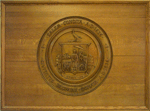Hamilton Hall: Difference between revisions
From Salem Links and Lore
No edit summary |
No edit summary |
||
| Line 1: | Line 1: | ||
*Located at 9 Chestnut Street, this famed building, designed by Samuel McIntire, was built in 1805 and named in honor of Alexander Hamilton, who had visited Salem, where he had many admirers. It was named a Registered National Historic Landmark for its architectural and historic significance. | *Located at 9 Chestnut Street, this famed building, designed by Samuel McIntire, was built in 1805 and named in honor of Alexander Hamilton, who had visited Salem, where he had many admirers. It was named a Registered National Historic Landmark for its architectural and historic significance. | ||
*The hall was built by wealthy Federalist merchants who wanted a place for dances and social gatherings after growing tensions with the Republicans resulted in the two groups refusing to share an assembly hall. | *The hall was built by wealthy Federalist merchants who wanted a place for dances and social gatherings after growing tensions with the Republicans resulted in the two groups refusing to share an assembly hall. | ||
*The hall's upstairs ballroom, where tall gilt-framed mirrors reflect the arched windows, makes the hall notable. The ballroom also has a wooden floor set upon springs, which cushions the movements of the dancers. Only a few of these type of floors remain intact in the country. | *The hall's upstairs ballroom, where tall gilt-framed mirrors (imported from Russia) reflect the arched windows, makes the hall notable. The ballroom also has a wooden floor set upon springs, which cushions the movements of the dancers. Only a few of these type of floors remain intact in the country. | ||
*Two other distinct features are the musician's balcony and on the first floor, a rare Rumford Roaster, which in the early 1800's was the most up-to-date means of cooking for large numbers. | *Two other distinct features are the musician's balcony and on the first floor, a rare Rumford Roaster, which in the early 1800's was the most up-to-date means of cooking for large numbers. | ||
*Hamilton Hall has maintained its original use as gathering place for dances, assemblies and community events. A group called the Ladies Committee of Hamilton Hall has sponsored lectures for over 60 years. | *Hamilton Hall has maintained its original use as gathering place for dances, assemblies and community events. A group called the Ladies Committee of Hamilton Hall has sponsored lectures for over 60 years. | ||
Revision as of 09:37, 17 October 2008
- Located at 9 Chestnut Street, this famed building, designed by Samuel McIntire, was built in 1805 and named in honor of Alexander Hamilton, who had visited Salem, where he had many admirers. It was named a Registered National Historic Landmark for its architectural and historic significance.
- The hall was built by wealthy Federalist merchants who wanted a place for dances and social gatherings after growing tensions with the Republicans resulted in the two groups refusing to share an assembly hall.
- The hall's upstairs ballroom, where tall gilt-framed mirrors (imported from Russia) reflect the arched windows, makes the hall notable. The ballroom also has a wooden floor set upon springs, which cushions the movements of the dancers. Only a few of these type of floors remain intact in the country.
- Two other distinct features are the musician's balcony and on the first floor, a rare Rumford Roaster, which in the early 1800's was the most up-to-date means of cooking for large numbers.
- Hamilton Hall has maintained its original use as gathering place for dances, assemblies and community events. A group called the Ladies Committee of Hamilton Hall has sponsored lectures for over 60 years.
- Proceeds from the series help to fund upkeep and renovation of this historic jewel. Interior work was done in 1920 and 1948. In 1988, bricks were repointed and windows repaired.
